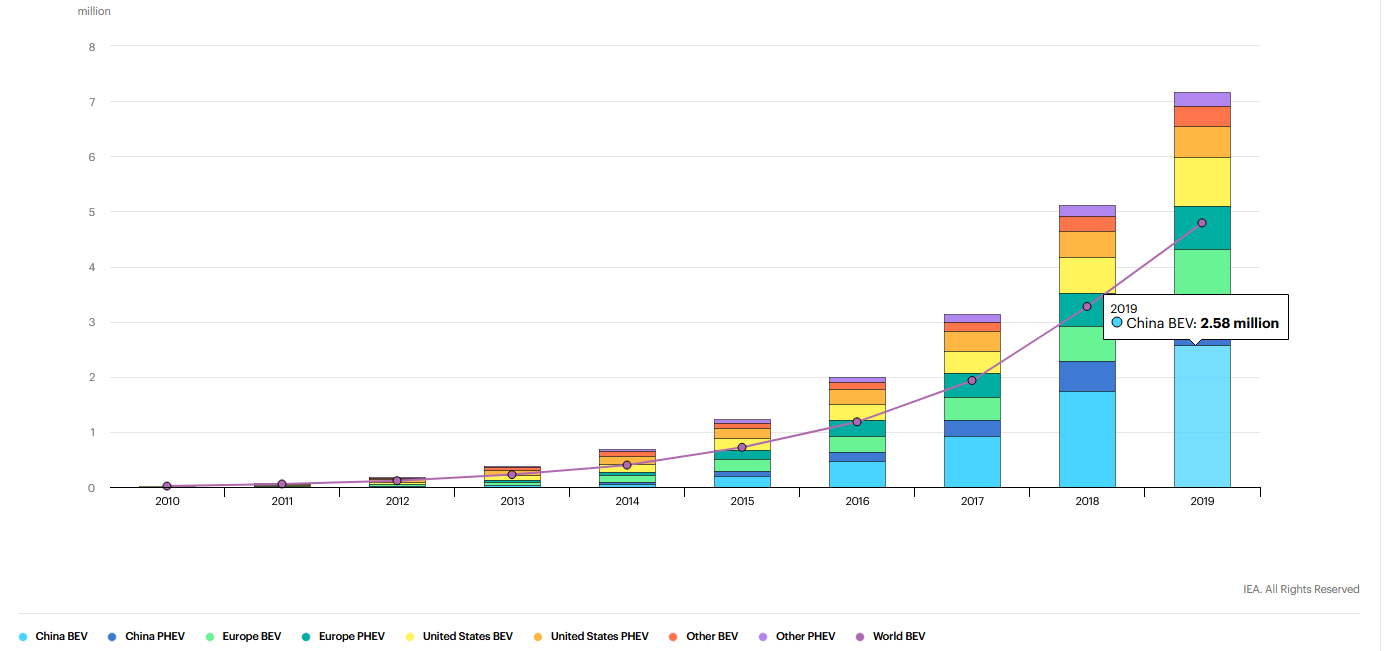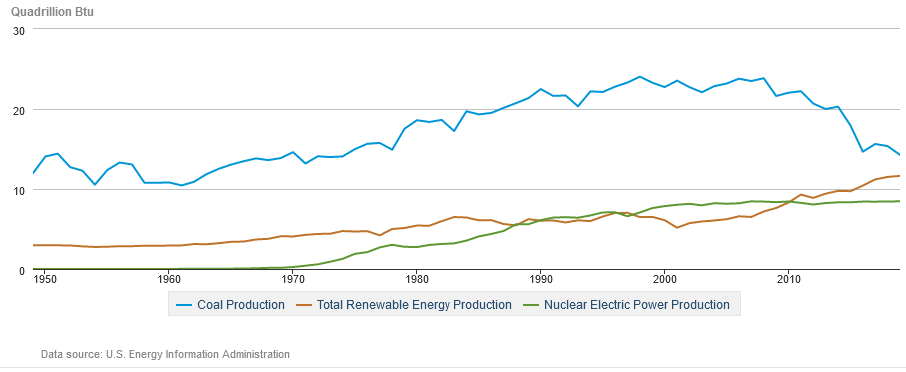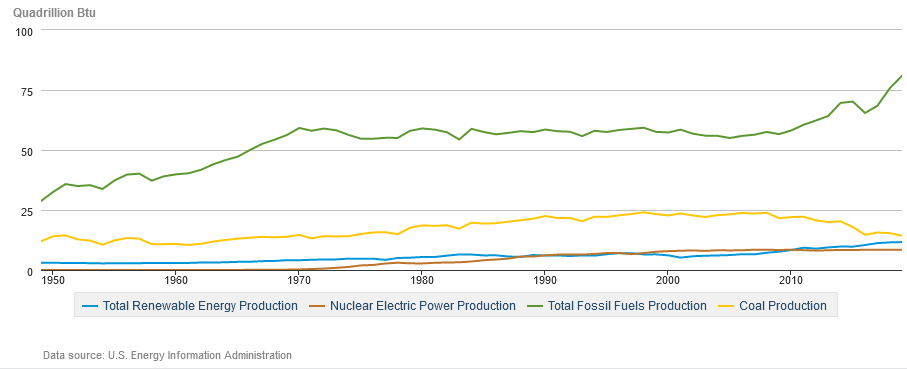-
Global Trends in Electric Vehicles →
In an earlier post, we learnt something that we do not see everyday, even if we work in a coal mine, as the variety of energy and the consumption end points blind us from looking at the full picture. Today, we will look at some trends that we see all around us, all the time - Electric vehicles (EVs).
For most of us, an electric car immediately reminds us of Tesla - the innovative American automobile manufacturer that is to become the world’s most valuable automobile company very soon. Tesla is also the company that created an electric car revolution. Tesla’s success, in many ways, drove other automakers to accelerate their offering of all-electric products. We saw that the transition was not overnight. Many built hybrid vehicles (HEV), range-extended electric vehicles, plug-in hybrid vehicles (PHEV), before building all electric, or battery electric vehicles (BEV). However, if one is to guess which country on the planet has the most number of electric cars it would most likely be the US or EU, because of Tesla and the likes of VW or BMW (both of which make electric cars). Let’s see how the actual answer unfolds.
IEA’s global outlook and data show some impressive numbers. To quote from their report,
Only about 17 000 electric cars were on the world’s roads in 2010. By 2019, that number had swelled to 7.2 million, 47% of which were in The People’s Republic of China.
Further, despite purchase subsidies for electric cars were cut in many geographies (like tax credits in the US) and the resulting drop in electric car sales, the total number electric vehicles in China, EU and the US are still very impressive - 2.58 million BEVs in China compared to 0.88 million BEVs in the US and 0.97 million BEVs in the EU.
One would start thinking what other industries are getting transformed along with the transformation of automotive industry. The implications of this transformation are huge touching several industries from service industry, retail and insurance. The analysis of the transformation itself would give fascninating insights. That would be the topic of a future post.
-
Covid vs Coal →
I was listening to an interesting news program on renewable energy recently that made claims and projections about the current state and future of energy - primarily about renewable energy overtaking coal as the major source of energy. As a result of Covid, demand for electricity has fallen and as coal has become more and more expensive than renewable counterparts, coal based electricity is facing an uphill battle. Will coal survive the covid crisis, in developed countries, is yet to be seen.
This prompted me to dig further into the data on energy production and consumption in the US. I was indeed surprised to see that coal based energy production is in fact decreasing in the US, and is decreasing drastically. I was surpised by two factors. First, I thought only under-developed or developing countries were the places where coal based energy was a major source, primarily due to the lack of infrastructure (like efficient transmission grids) and the cost of renewable energy (solar panels, wind turbines, etc.). Second, nuclear power production has flattened out somewhere in the last decade, and is now overtaken by renewable energy. With several nuclear power plants built over the decades, some of them dangerously close to fault lines, I was expecting more energy to be generated by nuclear plants. It turned out that was not the case.
Looking at the data, coal production is indeed decreasing and at such a rate that it is almost close to what it was in the 1950s. While renewable energy is all set to overtake coal based energy and experts predict 2020 to be the year for this to happen. In fact, renewable energy production has already overtaken nuclear energy.
While the above is certainly positive news, there are several other fossil fuels (natural gas, crude oil, etc.) just like there are several renewable energy sources (hydroelectric, solar, wind, etc.). Looking at more details at the different sources of fossil fuels, although coal production has reduced, total fossil fuel production is still way more than renewable energy production as the following chart shows.
Stay tuned for more insights into energy production and consumption in residential and transportation sectors.
-
Online Education - 'Right'ing the Privilege →
As we have been watching over the years, quality education no longer requires us to move to a different city to attend a quality university. It is available right on our smart device. With several universities around the world having some set of courses that are offered online and with the growth of several companies like Udacity, Coursera, Udemy and the like offering MOOCs (Massive Open Online Courses) the scale of reach for quality education is also much bigger - after all no university classroom is equipped to handle a million students simultaneously. So it is fair to say that anyone anywhere can get access to quality education right at their fingertips. Or is it? Are we missing something else?
The COVID pandemic has exposed the inqualities, not only in employment but also in access to quality education. With several schools shut, the only options several schools have is to deliver their courses online. While many schools themselves are not well equipped to deliver education as a digital service, many more students and their households do not have the means to provide them with the necessary infrastructure.
In a study, McKinsey & Co. compared 6th grade performance under different scenarios - returning to classrooms in 2020, early 2021 and mid 2021 and the results are shocking. The report also computes the average months of learning lost, due to low-quality remote learning, to be about 7-11 months even if schools open in early 2021 for in person learning.
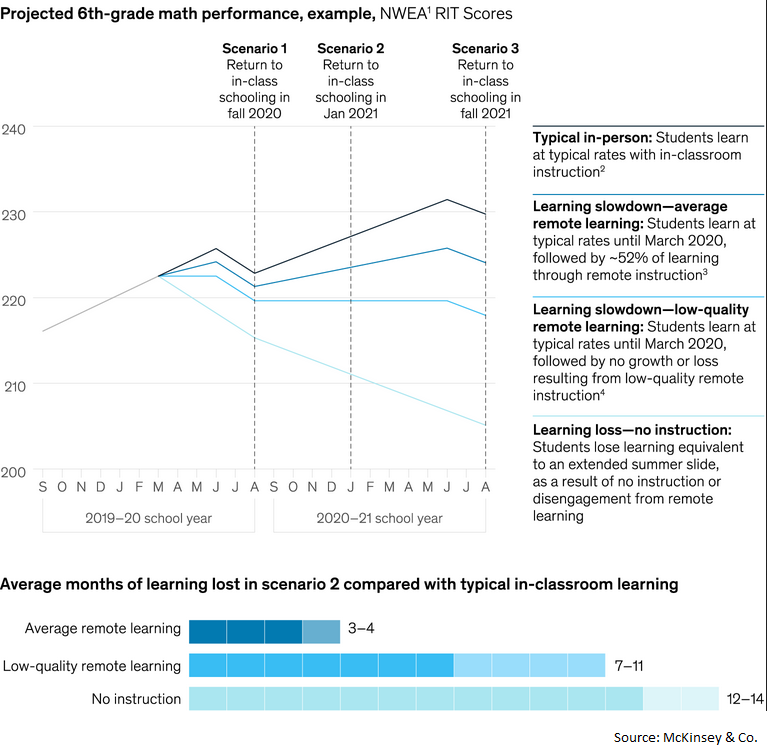
The report also says that this can have a drastic impact on the future of students and thereby the GDP of the country, due to many students dropping out of school due to their inability to access education.
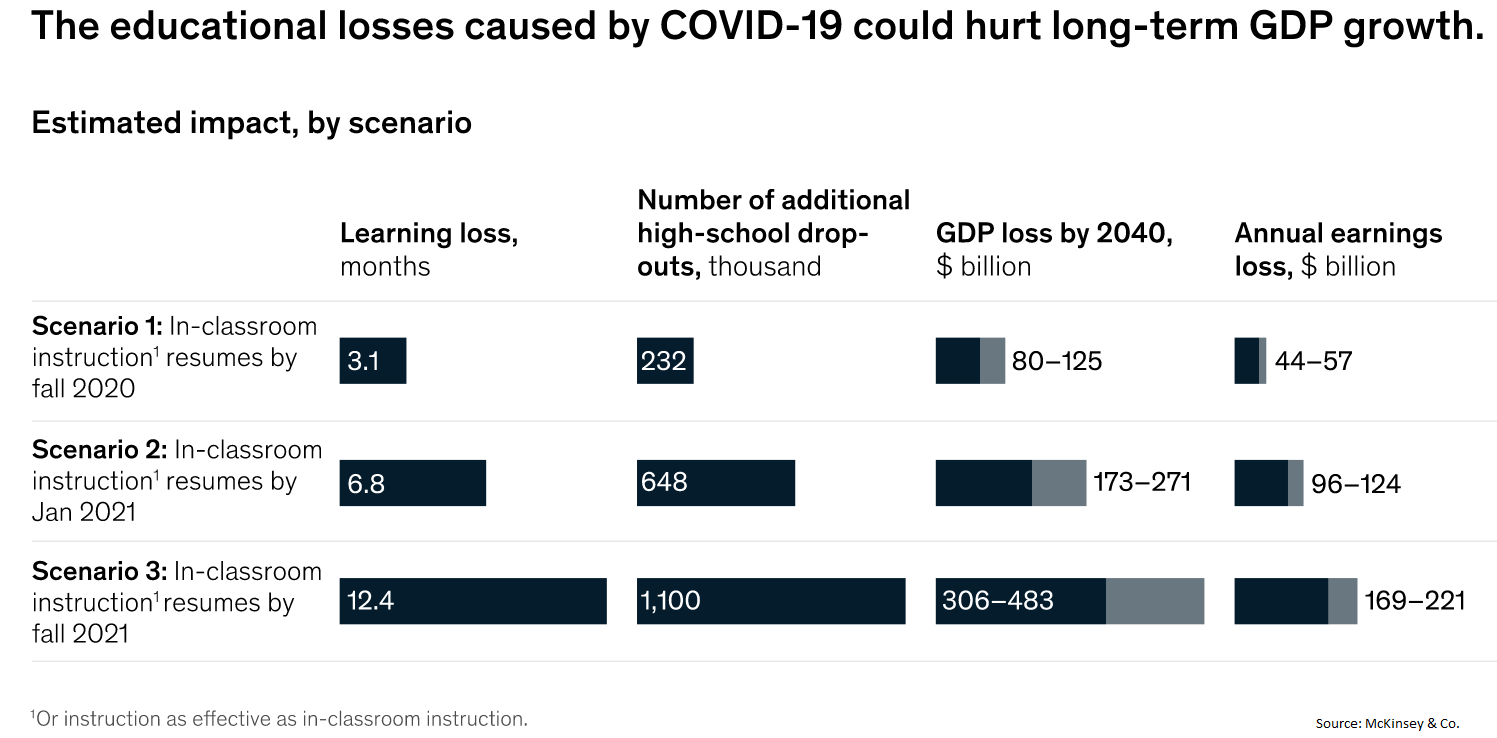
And these results might just be the tip of the iceberg. Even if the government is able to subsidise infrastructure needs for online education over the next several months, that alone is not going to solve the problem. The dynamics of online education, especially for younger children, have many challenges:
- There is a certain energy that is brought about by many teachers in the physical classroom, that motivates students to listen and learn. This is difficult for many teachers to replicate online.
- Just as not every YouTube video is interesting not every subject is going to be equally interesting when listened to online.
- Attention span of students away from a regular, formal school environment is going to be different (lower) and this would reduce the learning experience as well as the knowledge gained.
- Many schools and teachers may not be proficient or may not have the workforce to deal with the many system administration issues that need to be tackled in real-time for delivering classes online.
- Accessing such online education also requires relatively stable devices - even if chromebooks are relatively cheaper, many households - especially in the developing world where tablets and chromebooks are still a discretionary expense.
- Many parts of the developing world also do not have the necessary internet infrastructure to handle streaming videos at a large scale. Note that the number of students in a class in the developing world is also large.
- Moving from blackboard teaching to digital content creation takes time and it is not always easy.
- Some topics, like biology or chemistry labs, just cannot happen through remote learning.
- Students with learning disabilities would need the teacher in person in order to be able to learn
Given these various challenges and the data and projections provided in McKinsey & Co.’s report, it is fair to say that (online) education is still a privilege and not a right. What possible solutions could local governments, corporations and teachers come up with?
Governments could fast track the implementation of broadband networks, possibly by subsidising companies to do so in case the government is not able to do it themselves. Many other services, besides education, rely on efficient internet infrastructure and in the years to come, the number of services dependent on such infrastructure is only going to increase. They could also provide low income households with computing devices so that they can access education when delivered digitally. This reminds me of the days when state governments in India provided bicycles to students in government schools so that they can commute and access education provided in far away schools.
Corporations could make devices exclusively for school students. These need to be rugged, inexpensive and with a long battery life. In order for this to be feasible as a business, corporations could:
- Make the devices modular so that one could collect back damaged or older devices, recycle the parts into refurbished devices.
- Sacrifice non-essential elements that add up to the price (like different sets of fancy ports, etc.) for longer battery life and higher quality.
- Partner with school districts to loan such devices which could be collected back periodically for refurbishing.
- Collaborate on creating uniform content creation tools that would enable the teachers to create interesting content faster.
- Help teachers create engaging content from their knowledge of YouTube or Coursera views and feedback.
Teachers could learn to create engaging digital content - stories, animations and charts that would capture the interests of students, increasing their attention span even when in an environment different from regular classrooms. Teachers could:
- Collaborate and share content so that they can spend more time focussing on students’ development and learning than creating content.
- Collaborate and share best practices so that new teachers or even volunteers can get better at keeping the students engaged and teach.
There is also a big role parents play in such situations, along with teachers. These are extraordinary times - while technologies like Zoom and Cloud computing allow many of us to work remotely, education is one domain where despite technological advancements several challenges remain to be solved.
-
Streaming vs Cinemas in a post COVID world →
Watching a movie with stunning visual special effects, sound effects is best done in cinema halls. The screens are wide, the hall geometry and sound technologies like surrond sound add to the experience. It is no surprise that movies like Jurrasic Park, Inception, Avengers, etc. are best watched on large screen, in cinemas. It is not just the story, it is the movie experience, besides the social aspect of being outside and the lights going down. US box office revenues were 11.32 billion USD in 2019 and 11.89 billion USD in 2018 (all time best).
Lately, streaming has become very popular. It gives the convenience of watching the movie as and when one wanted, without having to drive to a cinema and at much lower price. A family of four can watch several movies in their living room for a monthly service fee of about $15, while a movie ticket would cost each of the family members as much. Added to this would be popcorn and soda. Netflix and lately almost every major studio is into streaming. Traditionally, movies were run in cinemas for about 90 days before getting released in digital format. But that 90 day “windowing” is coming under a lot of pressure with many streaming services deciding to release the movies right away in digital format.
So, we have two interesting and opposing forces - cinema halls and streaming services. One provides the best experience while the other provides convenience and affordability. And then came the COVID pandemic. With cinema halls being the sort of place that by design invited a large gathering in an enclosed room, it provided the perfect recipe for a pandemic spread. Cinema halls are closed and people are stuck at home having not much of an entertainment - a perfect recipe for streaming services to be at their best to relieve those sheltering in place of their boredom.
As if the scenario is not interesting enough, it was rumored that a popular movie streaming service - Amazon Prime Video made a bid for a popular cinema chain AMC. Although nothing of this is confirmed, the very thought process in analyzing this is interesting. What would be Amazon’s interest in AMC?
-
Amazon has a sizeable number of prime customers who get free shipping on goods and some deals on Whole Foods stores. Would Amazon give them monthly passes or subsidized tickets to watch movies in AMC?
-
Amazon Studios makes originals. Would those originals first be released in AMC and later streamed on Amazon Prime?
-
Would Amazon reserve AMC for the first few weeks, for movies with stellar visual and sound effects?
-
Would Amazon split the Studio products into TV shows like soaps for Amazon Prime and movies for AMC?
-
Would AMC become a Hollywood talent scouting arm for Amazon?
In all these, how would the pricing work? Amazon is known for maximizing efficiency and getting the best price for the end customer. Would it be able to replicate it in box office movies? If so, how? It is an interesting aspect waiting to be seen, if the rumours are true and if the deal goes through.
Till then, relax on your couch and stream your favorite shows.
-
-
Efficiency vs Flexibility →
Despite the date of posting, this post isn’t a joke and is meant to provoke some thoughts on efficiency and flexibility.
As a result of COVID-19 pandemic we saw the mad rush for toilet papers and other essentials that were getting swept off super-market shelves. Not just toilet papers, even face-masks and ventilators were in short supply at a time when they were most needed. Many consumer and semiconductor companies lowered their guidance due to disruptions in their supply chain. How did we get into a situation where so many industries - from toilet papers to iPhones were getting affected?
The world over the many years got more globalized. American or Canadian products were not made in the US or Canada. They were made in places where it was cheaper and faster to make. Even trash is sent to other countries in order to be recycled in a cost-effective manner. In short, global supply chain over the years shaped its goal into one that is more cost efficient rather than being flexible. This is not the first time companies are facing shocks. Not long ago, floods in Japan resulted in supply chain issues for automotive companies.
Is this design for efficiency a problem? It definitely looks like, given what many countries went through as the COVID-19 pandemic stuck. Many companies were not able to reliably source their material and keep their assembly lines busy, as they were over-invested in the most (cost) efficient supply chains like in China. If instead the supply chains were designed for flexibility, the average marginal cost of a product “might be” (and just might be) a little higher but geography specific events would not throw the entire system out of gear. There is an emphasis on the uncertainity of the cost implications as it is not entirely clear at this point. For example, one could argue that, if the semiconductor industry had sourced from several geographies like China, India, Africa, South America, etc., it is very likely that the infrastructure for sustaining such supply chains would have developed in many such countries creating a healthy competition, thereby reducing the cost. And this applies to several industries, not just semiconductors.
Have the corporates learnt a lesson now?. There was a similar talk after supply chain disruptions in Japan, but nothing materialized in the long run. Would this time be different? One has to wait and watch.
